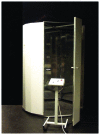Vitamin D and UV exposure in chronic kidney disease
- PMID: 24494043
- PMCID: PMC3897578
- DOI: 10.4161/derm.24539
Vitamin D and UV exposure in chronic kidney disease
Abstract
With loss of renal function and decreasing glomerula filtration rate the serum levels of 25-hydroxyvitamin D [25(OH)D] as well as 1,25-dihydroxyvitamin D [1,25 (OH)2 D] often decrease simultaneously. In representative groups of German patients on renal replacement therapy (hemodialysis, peritoneal dialysis, kidney transplantation) our group retrospectively analyzed the vitamin D status over a period of 12 y (1995‒2006). Only 11% of patients had a serum level of 25(OH)D that was > 30 ng/ml, more than 70% had a level of 25(OH)D < 20 ng/ml. In clinical trials we used sun-simulating artificial lamps to produce vitamin D3 in the skin. Partial-body irradiation (15% of body surface) was used during the routine hemodialysis treatment. Whole-body UV exposure was done in a standing position three times a week before the hemodialysis treatment. With both procedures we observed an increase of the serum level of 25(OH)2D3 by approx. 35-50% over a period of 2‒3 mo, maintenance of trabecular bone mineral density and a normalization of systolic and diastolic blood pressure. Heart rate variability improved during the whole-body radiation intervention period by 20‒25%. Patients who continued the whole-body irradiation regularly two or three times before starting the routine hemodialysis session had maintained normal levels of circulating 25(OH)D3 and of 1,25(OH)2D3. Therefore, from our data it can be recommended that intermittent suberythemal UVB exposure with a sun-simulation spectrum is effective to treat and/or protect against vitamin D deficiency in chronic and end-stage kidney disease patients.
Keywords: 1,25-Dihydroxyvitamin D; 25-Hydroxyvitamin D; bone mineral density; chronic kidney disease; hypertension; vitamin D3.
Figures









Similar articles
-
Partial Body UV Exposure in Chronic Kidney Disease and Extrarenal Vitamin D Metabolism.Anticancer Res. 2018 Feb;38(2):1217-1219. doi: 10.21873/anticanres.12342. Anticancer Res. 2018. PMID: 29374760
-
1alpha(OH)D3 One-alpha-hydroxy-cholecalciferol--an active vitamin D analog. Clinical studies on prophylaxis and treatment of secondary hyperparathyroidism in uremic patients on chronic dialysis.Dan Med Bull. 2008 Nov;55(4):186-210. Dan Med Bull. 2008. PMID: 19232159 Review.
-
Vitamin D Status in Chronic Kidney Disease - UVB Irradiation Is Superior to Oral Supplementation.Anticancer Res. 2016 Mar;36(3):1397-401. Anticancer Res. 2016. PMID: 26977042
-
[Changes in mineral metabolism in stage 3, 4, and 5 chronic kidney disease (not on dialysis)].Nefrologia. 2008;28 Suppl 3:67-78. Nefrologia. 2008. PMID: 19018742 Spanish.
-
The kidney as an endocrine organ involved in the function of vitamin D.Am J Med. 1975 Jan;58(1):39-47. doi: 10.1016/0002-9343(75)90531-8. Am J Med. 1975. PMID: 163578 Review.
Cited by
-
Assessment of Vitamin D Metabolism Disorders in Hemodialysis Patients.Nutrients. 2025 Feb 22;17(5):774. doi: 10.3390/nu17050774. Nutrients. 2025. PMID: 40077644 Free PMC article.
-
Vitamin D and Cardiovascular Risk in Children.Chin Med J (Engl). 2017 Dec 5;130(23):2857-2862. doi: 10.4103/0366-6999.215500. Chin Med J (Engl). 2017. PMID: 28948941 Free PMC article. Review.
-
Association between ambient carbon monoxide and secondary hyperparathyroidism in nondiabetic patients undergoing peritoneal dialysis.Ther Clin Risk Manag. 2015 Sep 16;11:1401-8. doi: 10.2147/TCRM.S91475. eCollection 2015. Ther Clin Risk Manag. 2015. PMID: 26396525 Free PMC article.
-
Anti-Photoaging Effects of Low Molecular-Weight Fucoidan on Ultraviolet B-Irradiated Mice.Mar Drugs. 2018 Aug 18;16(8):286. doi: 10.3390/md16080286. Mar Drugs. 2018. PMID: 30126169 Free PMC article.
-
Consensus statement from 2nd International Conference on Controversies in Vitamin D.Rev Endocr Metab Disord. 2020 Mar;21(1):89-116. doi: 10.1007/s11154-019-09532-w. Rev Endocr Metab Disord. 2020. PMID: 32180081 Free PMC article.
References
-
- Kidney Disease. Improving Global Outcomes (KDIGO) CKD-MBD Work Group KDIGO clinical practice guideline for the diagnosis, evaluation, prevention, and treatment of Chronic Kidney Disease- Mineral and Bone Disorder (CKD-MBD) Kidney Int. 2009;113:S1–130. - PubMed
Publication types
LinkOut - more resources
Full Text Sources
Other Literature Sources
